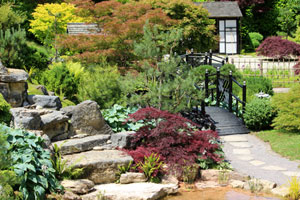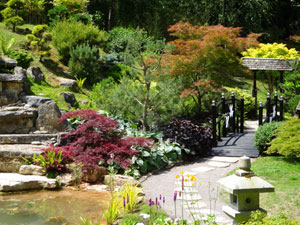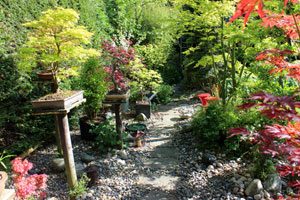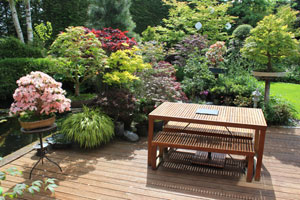Introduction to Oriental Gardens and Landscaping Ideas
Japanese Garden Design

To create a truly authentic traditional Japanese tea garden is not an easy task for any Western gardener, novice or experienced.
With a little in the way of imagination, a relatively modest budget and plenty of patience, anyone can add an oriental flavour to their back garden, with just a pot of bamboo, an airy purple Japanese maple and a strategically placed Buddha statue.
Elements and Features
There are countless elements to be considered with any Japanese garden design, with the end result ideally being a stylised representation of nature - in miniature.

To successfully combine water features, boulders and rocks, trees, flowering plants, meandering pathways, statues and granite lanterns needs a little thought and foreplanning, skill, and perhaps a touch of trial and error.
You should not be overly concerned about the accuracy of the placement of individual design elements and their relationship to each other. Instead, it is the overall oriental feel created by the garden that is most important.
Designing and Planning

When designing, planning and landscaping any Japanese garden, try to aim for a cohesive layout, with many individual components that all fit together without standing out and overpowering the design.
If you don't have the space or time for a koi pond, then perhaps a bubbling water feature made with a round granite basin will be a suitable alternative. And if you are unable to plant directly in the ground, then group some pots together in a corner and plant them up with some oriental plants, aiming to reflect nature wherever possible and to create a harmonious space for contemplation.
Pathways are a fundamental part of any Japanese garden design, ranging from granite paving slabs and gravel footpaths, to a simple line of stepping stones. However, it is important that your pathway winds its way around the layout, so that when you are walking around the garden you don't rush, but are instead prompted to pause at times, enjoying the plants and the tranquility that the design provides.

Western Interpretations
A classical Western garden generally features a green lawn at its centre and borders around the edge. However, a Japanese garden is designed to take you on a journey through the seasons of nature, with cherry blossom and azalea flowers in the spring, fresh summer foliage with clipped topiary-like shapes, autumnal shades provided by maples, and pine tree needles covered with snow in the winter months.
Consider how your garden scene will look from the window of your house and plan your landscape design carefully, so that you are not able to see the whole garden at a glance. Instead, use plants, bamboo fences and large granite lanterns to hide sections, to provide more interest and make you want to explore the network of pathways that you have created.
If you can borrow some background scenery (shakkei) comprising established trees, then try to incorporate these views into your design. And don't forget to include a seating area or two, so that you can sit back and enjoy your oriental garden as it grows and evolves around you.

Chinese Influences
Unless your are a real stickler for detail and accuracy, don't be afraid to add some Chinese elements as well. For most, they will simply be oriental features, and history shows that many elements of a modern-day Japanese garden actually have their roots firmly in China anyway.
N.B. This website is not intended to be an exhaustive guide to designing authentic Japanese gardens. It has been written to inspire you to have a go at creating something yourself, an interpretation that brings a touch of Japan to your back garden in an East meets West manner. Any design will involve a certain amount of personal taste, which is often subjective, and so the most important thing is that you enjoy your horticultural creation yourself.
 To create a truly authentic traditional Japanese tea garden is not an easy task for any Western gardener, novice or experienced.
To create a truly authentic traditional Japanese tea garden is not an easy task for any Western gardener, novice or experienced. To successfully combine water features, boulders and rocks, trees, flowering plants, meandering pathways, statues and granite lanterns needs a little thought and foreplanning, skill, and perhaps a touch of trial and error.
To successfully combine water features, boulders and rocks, trees, flowering plants, meandering pathways, statues and granite lanterns needs a little thought and foreplanning, skill, and perhaps a touch of trial and error. When designing, planning and landscaping any Japanese garden, try to aim for a cohesive layout, with many individual components that all fit together without standing out and overpowering the design.
When designing, planning and landscaping any Japanese garden, try to aim for a cohesive layout, with many individual components that all fit together without standing out and overpowering the design.
